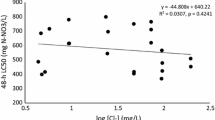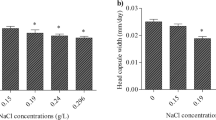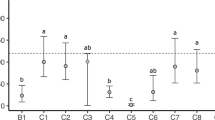Abstract
Lithium (Li) is the lightest metal and occurs primarily in stable minerals and salts. Concentrations of Li in surface water are typically <0.04 mg l−1 but can be elevated in contaminated streams. Because of the general lack of information concerning the toxicity of Li to common toxicity test organisms, we evaluated the toxicity of Li to Pimephales promelas (fathead minnow), Ceriodaphnia dubia, and a freshwater snail (Elimia clavaeformis). In the laboratory, the concentration of Li that inhibited P. promelas growth or C. dubia reproduction by 25% (IC25) was dependant upon the dilution water. In laboratory control water containing little sodium (∼2.8 mg l−1), the IC25s were 0.38 and 0.32 mg Li l−1 and in ambient stream water containing ∼17 mg Na l−1, the IC25s were 1.99 and 3.33, respectively. A Li concentration of 0.15 mg l−1 inhibited the feeding of E. clavaeformis in laboratory tests. Toxicity tests conducted to evaluate the effect of sodium on the toxicity of Li were conducted with fathead minnows and C. dubia. The presence of sodium greatly affected the toxicity of Li. Fathead minnows and Ceriodaphnia, for example, tolerated concentrations of Li as great as 6 mg l−1 when sufficient Na was present. The interaction of Li and Na on the reproduction of Ceriodaphnia was investigated in depth and can be described using an exponential model. The model predicts that C. dubia reproduction would not be affected when animals are exposed to combinations of lithium and sodium with a log ratio of mmol Na to mmol Li equal to at least 1.63. The results of this study indicate that for most natural waters, the presence of sodium is sufficient to prevent Li toxicity. However, in areas of historical disposal or heavy processing or use, an evaluation of Li from a water quality perspective would be warranted.
Similar content being viewed by others
References
Ahearn, G.A. and Clay, L.P. (1989). Kinetic analysis of electrogenic 2 Na+-1 H+ antiport in crustacean hepatopancreas. Am. J. Physiol. 257, R484-93.
Ahearn, G.A. and Franco, P. (1991). Electrogenic 2Na+/H+ antiport in echinoderm gastrointestinal epithelium. J. Exp. Biol. 158, 495-507.
Ahearn, G.A., Zhuang, A., Duerr, J. and Pennington, V. (1994). Role of the invertebrate electrogenic 2 Na+-1 H+ antiporter in monovalent and divalent cation transport. J. Exp. Biol. 196, 319-35.
Anderson, B.G. (1946). The toxicity threshold of various sodium salts determined by the use of Daphnia magna. Sewage Works J 18, 82-87.
Anderson, B.G. (1948). The apparent thresholds of toxicity to Daphnia magna for chlorides of various metals when added to Lake Erie water. Trans. Am. Fish. Soc. 78, 96-113.
Bennett, W.M. (1997). Drug interactions and consequences of sodium restriction. Am. J. Clin. Nutr. 65(suppl. 2), 678S-681S.
Bleiwas, D.I. and Coffman, J.S. (1986). Lithium availability-market economy countries, Bureau of Mines Information Circular 9102, 23 pp.
Burris, J.A., Bamford, M.S. and Stewart, A.J. (1990). Behavioral responses of marked snails as indicators of in situ toxicity. Environ. Toxicol. Chem. 9, 69-76.
Bury, N.R., McGeer, J.C. and Wood, C.M. (1999). Effects of altering freshwater chemistry on physiological responses of rainbow trout to silver exposure. Environ. Toxicol. Chem. 18, 49-55.
Davis, B.A., Hogan, E.M. and Boron, W.F. (1992). Activation of Na-H exchange by intracellular lithium in barnacle muscle fibers. Am. J. Physiol. 263, C246-56.
Dickson, J.S., Dillaman, R.M., Roer, R.D. and Roye, D.B. (1991). Distribution and characterization of ion transporting and respiratory filaments in the gills of Procambarus clarkii. Biol. Bull. 180, 154-66.
Duerr, J.M. and Ahearn, G.A. (1996). Characterization of a baso-lateral electroneutral Na+/H+ antiporter in atlantic lobster (Homarus americanus) hepatopancreatic epithelial vesicles. Jr. Exp. Biol. 199, 643-51.
Durfor, C.N. and Becker, E. (1964). Public water supplies of the 100 largest cities in the United States, 1962, U.S., Geological Survey Water Supply Paper 1812. 364 p.
Emery, R.D., Klopfer, C. and Skalski, J.R. (1981). The incipient toxicity of lithium to freshwater organisms representing a salmonid habitat. PNL-3640, UC-11, Pacific Northwest Laboratory: Richland, WA.
EPA (US Environmental Protection Agency) (1993). A linear interpolation method for sublethal toxicity: The inhibition concentration (ICp) approach (version 2.0), National Effluent Toxicity Assessment Center Technical Report 03-93, Environmental Research Laboratory: Duluth, MN.
EPA (US Environmental Protection Agency) (1994). Short-term methods for estimating the chronic toxicity of effluents and receiving water to freshwater organisms (third edition). EPA/600/4-91/002. U.S. Environmental Protection Agency, Cincinnati, OH, Environmental Monitoring Systems Laboratory.
Grinstein, S. and Wieczorek, H. (1994). Cation antiports of animal plasma membranes. J. Exp. Biol. 196, 307-18.
Grosell, M., Hogstrand, C., Wood, C.M. and Hansen, H.J.M. (2000). A nose-to-nose comparison of the physiological effects of exposure to ionic silver versus silver chloride in the European eel (Anguilla anguilla) and the rainbow trout (Oncorhynchus mykiss). Aquat. Toxicol. 48, 327-42.
Hall, L.W. and Anderson, R.D. (1995). The influence of salinity on the toxicity of various classes of chemicals to aquatic biota. Crit. Rev. Toxicol. 24, 281-49.
Hamilton, S.J. (1995). Hazard assessment of inorganics to three endangered fish in the Green River, Utah. Ecotoxicol. Environ. Safety 30, 134-42.
Hill, B.R. and Gilliom, R.J. (1993). Streamflow, dissolved solids, suspended sediment, and trace elements, San Joaquin River, California, June 1985–September 1988, United States Geologial Survey Open-File Report, Water-Resources Investigations Report 93-4085. Denver, CO.
Hutchinson, G.E. (1975). A Treatise on Limnology, Vol 1, Part 2—Chemistry of Lakes. New York: John Wiley.
Kikuchi, S. (1983). The fine structure of gill epithelium of a fresh-water flea, Daphnia magna (Crustacea: Phyllopoda) and changes associated with acclimation to various salinities. I. Normal fine structure. Cell Tissue Res 229, 53-68.
Kinsella, J.L. and Aronson, P.S. (1981). Interaction of NH4 + and Li+ with the renal microvillus membrane Na+-H+ exchanger. Am. J. Physiol. 241, C220-6.
Klemfuss, H. and Greene, K.E. (1991). Cations affecting lithium toxicity and pharmacology. In G.N. Schrauzer and K.F. Klippel (eds), Lithium in Biology and Medicine, pp. 131-45. New York: VCH Publishers.
Kszos, L.A. and Stewart, A.J. (2003). Review of lithium in the aquatic environment: Distribution in the United States, toxicity and case example of groundwater contamination. Ecotoxicology 12, 439-447.
Long, K E., Brown, R.P. Jr and Woodburn, K.B. (1998). Lithium chloride: a flow-through embryo-larval toxicity test with the fathead minnow, Pimephales promelas Rafinesque. Bull. Environ. Contam. Toxicol 60, 312-17.
Mathis, B.J. and Cummings, T.F. (1973). Selected metals in sediments, water and biota of the Illinois River. J. Water Pollution Control Federation 45, 1573-83.
Ober, J.A. (2001). Lithium—2000. In Minerals Yearbook, Metals & Minerals.U.S. Geological Survey, Minerals Information: Reston, VA, URL: http://minerals.usgs.gov/minerals/pubs/commodity/lithium/.
Rand, G.M. and Petrocelli, S.R. (1985). Fundamentals of Aquatic Toxicology. Hemisphere: Washington, 666 pp.
SAS (1985). SAS ® User's Guide: Statistics, Version 5 Edition. SAS Institute Inc: Cary, 956 pp.
Santore, R.C., Di Toro, D.M., Paquin, P.R., Allen, H.E. and Meyer, J.S. (2001). Biotic ligand model of the acute toxicity of metals. 2. Application to acute copper toxicity in freshwater fish and Daphnia. Environ. Toxicol. Chem. 20, 2397-402.
Schrauzer G.N. and Kippel K.F. (eds) (1991). Lithium in Biology and Medicine, 209 pp, New York: VCH Publishers.
Shetlar, R.E. and Towle, D.W. (1989). Electrogenic sodium-proton exchange in membrane vesicles from crab (Carcinus maenas) gill. Am. J. Physiol. 257, R924-31.
Stewart, A.J., Hill, W.R. and Boston, H.L. (1993). Grazers, periphyton and toxicant movement in streams. Environ. Toxicol. Chem. 12, 955-7.
Tanner, D.Q. (1995). Surface-Water-Quality Assessment of the Lower Kansas River Basin, Kansas and Nebraska: Distribution of Trace-Element Concentrations in Dissolved and Suspended Phases, Streambed Sediment, and Fish Samples, May 1987–April 1990, Lawrence, Kansas: USGS Water-Resources Investigations Report 94-4201, Denver, CO.
Thomsen, K. and Leyssac, P.P. (1986). Acute effects of various diuretics on lithium clearance-studies in rats on medium and low sodium diet. Renal Phys. Biochem. 9, 1-8.
Thomsen, K. and Leyssac, P.P. (1987). Effect of sodium-poor diet on lithium clearance at different dietary potassium conents in rats. Pharmacol. Toxciol. 61, 260-4.
Venugopal, B. and Luckey, T.D. (1978). Metal Toxicity in Mammals. Vol. 2, New York: Plenum Press.
Williams, R.J.P. (1973). The chemistry and biochemistry of lithium. In S. Gershon and B. Shopsin (eds), Lithium: Its Role in Psychiatric Research and Treatment, pp. 15-31. New York: Plenum Press.
Yu, F.H.Shull, G.E. Orlowski, J. (1993). Functional properties of the rat Na/H exchanger NHE-2 isoform expressed in Na/H exchanger deficient Chinese hamster ovary cells. J. Biol. Chem. 268, 25536-41.
Author information
Authors and Affiliations
Corresponding author
Rights and permissions
About this article
Cite this article
Kszos, L.A., Beauchamp, J.J. & Stewart, A.J. Toxicity of Lithium to Three Freshwater Organisms and the Antagonistic Effect of Sodium. Ecotoxicology 12, 427–437 (2003). https://doi.org/10.1023/A:1026160323594
Issue Date:
DOI: https://doi.org/10.1023/A:1026160323594




